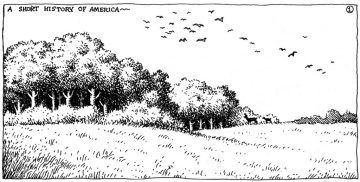Ivan Brunetti at the Paris Review:
 The comic is bookended by two pieces of nondiegetic text. We start with the title hovering above a pastoral scene, nature as yet unspoiled: trees, deer, birds, and a gently sloping hill. We can safely assume this is America, but when? It could be yesterday, or thousands of years ago. We deduce that the second panel shows this same setting not long after, because of a key continuity: the trees, placed in the same position inside the two panels, haven’t grown much. Our eyes adjust quickly to repetition and become acutely sensitive to any deviation, however small. Instantly, we take in the hill and felled trees, along with the introduction of the railroad track, upon which chugs a small train, billowing steam as it disappears into the distance. The wild animals are gone, a visual shorthand for the encroachment of humans. Because of the train’s presence, we infer that these first two panels take place in the early-to-mid-nineteenth century. In the third panel, a few birds glide in the sky, recalling the first panel. The hill remains in the scene (though altered), as well as the train track, but years must have passed, because we also see a house, shed, and cart (signifying “farm”), as well as a dirt road (signifying “town”), telegraph wires, and a man with horse and buggy. Will this fellow be our main character?
The comic is bookended by two pieces of nondiegetic text. We start with the title hovering above a pastoral scene, nature as yet unspoiled: trees, deer, birds, and a gently sloping hill. We can safely assume this is America, but when? It could be yesterday, or thousands of years ago. We deduce that the second panel shows this same setting not long after, because of a key continuity: the trees, placed in the same position inside the two panels, haven’t grown much. Our eyes adjust quickly to repetition and become acutely sensitive to any deviation, however small. Instantly, we take in the hill and felled trees, along with the introduction of the railroad track, upon which chugs a small train, billowing steam as it disappears into the distance. The wild animals are gone, a visual shorthand for the encroachment of humans. Because of the train’s presence, we infer that these first two panels take place in the early-to-mid-nineteenth century. In the third panel, a few birds glide in the sky, recalling the first panel. The hill remains in the scene (though altered), as well as the train track, but years must have passed, because we also see a house, shed, and cart (signifying “farm”), as well as a dirt road (signifying “town”), telegraph wires, and a man with horse and buggy. Will this fellow be our main character?
more here.
